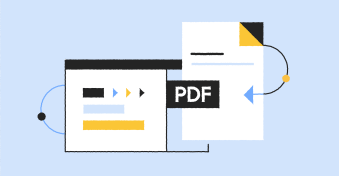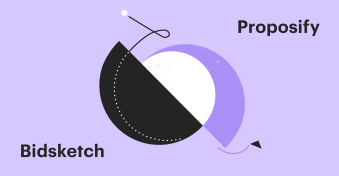Looking for Proposify alternatives?
Proposify was established back in 2013 and has proven itself as a strong and resilient player in the proposal software niche. Currently, the platform features:
- Legally binding e-signatures.
- Robust proposal design tools.
- Deep document analytics and insights.
- Automation workflows and template optimizations.
- Team management and collaboration tools.
- CRM and productivity integrations.
- Industry-leading document encryption and security.
- And much more.
This collection of features has made Proposify one of the most prominent (and scalable!) online signature solutions.
However, a number of strong Proposify competitors have also launched into the market since those early days. (At last count, there are roughly 75 Proposify alternatives on the market.)
In this guide, we’ll talk you through a number of Proposify alternatives, what they have to offer, where they differ, and how they measure up.
Let’s get started.
Key takeaways
- In terms of proposal design, Proposify provides a toolkit that is largely unmatched by competitors. Only PandaDoc and Qwilr provide equivalent outputs.
- Proposify sometimes falls short in areas around automation, integration, and streamlining.
- Proposify’s lack of flexible pricing (one plan only, aside from Enterprise), makes it an all-or-nothing plan in a market where competitors offer a wide range of solutions at varying price points.
01. PandaDoc
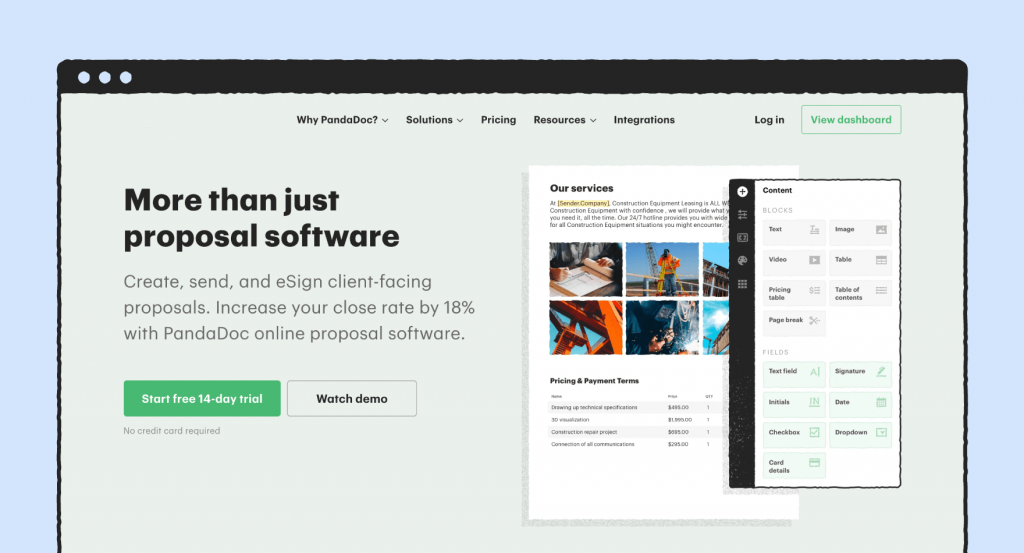
Our rating: 4.8/5
Pricing: Free eSign ($0); Essentials ($19 user/month); Business ($49 user/month); Enterprise pricing available.
Who is this tool for? Businesses and teams looking to automate and scale their document workflow.
PandaDoc is an all-in-one digital document and contract management solution created to automate contract and tracking processes, ensure secure collaboration, and provide proper management.
| Features | Proposify | PandaDoc |
|---|---|---|
| Legally-binding eSignatures with Audit Trail | ✓ | ✓ |
| Templates | ✓ | ✓ |
| Activity notifications | ✓ | ✓ |
| Payments collection | Stripe | ✓ |
| Automated workflows | Limited | ✓ |
| Custom branding for documents, templates, and emails | ✓ | ✓ |
| CRM integrations | ✓ | ✓ |
| API (including Sandbox API) | X | ✓ |
| Document generation and editing | ✓ | ✓ |
| Document analytics and insights | ✓ | ✓ |
| Free trial | 14 Days | 14 Days |
| Customer Support | ||
| Email / Support Ticket | ✓ | ✓ |
| 24/7 Chat Support | X | ✓ |
| Phone | $ | X |
| Success manager | $ | ✓ |
| Onboarding services | $ | $ |
The tool can support any business process requiring document management and electronic signatures due to its contract management platform flexibility.
PandaDoc’s main advantage is its ability to upload nearly any type of contract documents, from Word to PDF, and fold it into a unified contract management workflow.
While you can also use the PandaDoc document editor to build proposals and contracts from scratch, you can also use integrations with Microsoft Word or Google Docs to bring e-signing to your existing document workflow.
Put another way: PandaDoc is one of the rare software tools that can truly meet your team where they are, bringing a new feature set to existing applications that they are already comfortable using.
Users also appreciate that PandaDoc acts as a contract repository for teams, being exceptionally user-friendly for both internal and external parties.
On top of everything else, small businesses looking purely for an electronic signature solution can save on their budget and use PandaDoc entirely free with the Free eSign plan!
This makes PandaDoc a useful option for startups and other companies with budget limitations, allowing them to step away from simple signing solutions like DocuSign at no cost.
Proposify vs PandaDoc
In many ways, both PandaDoc and Proposify offer several product similarities. However, there are some key differences.
PandaDoc is a multi-functional contract lifecycle management software with an assortment of options available to manage contract works efficiently.
Much like Proposify, PandaDoc software allows you to build documents entirely from scratch using an in-app editor.
After the documents are shared, the platform becomes a central meeting place where stakeholders can review, negotiate, customize, and sign contracts and proposals.
Both platforms allow teams to leverage analytics and tracking to gather detailed insights about their contracts, expenditures, and revenue over time.
You’ll also find that data is protected using industry-leading security protocols that are compliant with GDPR, HIPAA, SOC2 Type 2 standards.
PandaDoc is also equipped with a number of integrations, allowing users to connect to their existing tech stack, import data from CRMs like Salesforce, and much more.
Proposify has slightly fewer native integrations in their arsenal, but Zapier is an option on both platforms if you need to build a third-party connection.
When it comes to teams, PandaDoc offers customizable user management, including a flexible approval process, multiple account roles, templating tools for faster sending, and more.
Proposify also includes many of these tools, so account owners and managers will feel comfortable when transitioning between platforms.
In our view, PandaDoc begins to stand out when you begin to factor for team flexibility. For example, both platforms allow users to collect payments via a payment gateway.
But, with Proposify, you can only use Stripe for that. PandaDoc provides multiple payment integration options, including Stripe, PayPal, and Authorize.net.
The same is true for workflow automations, as well as the ability to fold PandaDoc into your existing workflow.
Unlike Proposify, PandaDoc provides API access so that developers can adapt PandaDoc features into the tools and software applications that your team regularly uses.
For many teams, the combination of project management and document design tools make PandaDoc the perfect alternative to Proposify.
Want to know more? Check out this itemized breakdown to see how PandaDoc and Proposify truly measure up:
02. Qwilr
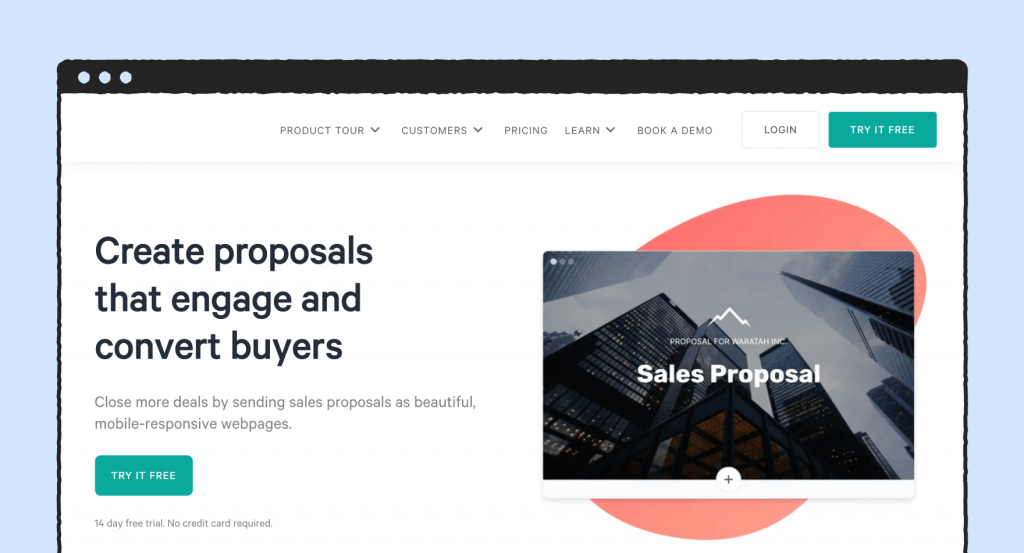
Our rating: 4.3/5
Pricing: Business ($35/month); Enterprise ($590/month, min. 10+ users).
Who is this tool for? Teams who want to bring the look and feel of innovative web design to their document process.
Qwilr takes a unique approach to proposal design by aiming to create a sales experience that closely resembles a website landing page.
This change creates a departure from the traditional look and feel of a traditional sales document, allowing teams to give their sales proposals and contracts and look and feel that is difficult to replicate in other software tools.
The platform features a content editor and dynamic pricing tables to assist with document design.
At the enterprise level, you can also use custom domains and import data with Salesforce integrations.
The Qwilr approach can still integrate well with a standard sales process while giving your sales experience a facelift that customers will remember when faced with piles of same-old proposal documents.
| Features | Proposify | Qwilr |
|---|---|---|
| Legally-binding eSignatures with Audit Trail | ✓ | ✓ |
| Templates | ✓ | ✓ |
| Activity notifications | ✓ | ✓ |
| Payments collection | Stripe | Stripe |
| Automated workflows | Limited | X |
| Custom branding for documents, templates, and emails | ✓ | ✓ |
| CRM integrations | ✓ | Limited |
| API (including Sandbox API) | X | $ |
| Document generation and editing | ✓ | ✓ |
| Document analytics and insights | ✓ | ✓ |
| Free trial | 14 Days | 14 Days |
| Customer Support | ||
| Email / Support Ticket | ✓ | 24/5 |
| 24/7 Chat Support | X | Limited |
| Phone | $ | ✓ |
| Success manager | $ | ✓ |
| Onboarding services | $ | ✓ |
Proposify vs Qwilr
Unlike Proposify and most of its software rivals, Qwilr’s primary focus isn’t on creating sales documents. (Check out Qwilr’s primary competitors right here.)
Instead, Qwilr produces a fully interactive web page once you’re done designing your business proposals, bringing something entirely new to the table.
The pages are mobile-responsive and include numerous pieces of embedded content, including video, dynamic pricing tables, and Google Maps.
Compared to Proposify, the platform provides an entirely different output that fills a very similar role.
Even with Proposify’s flexible design tools, the end-result will still be a proposal document. With Qwilr, it’s a web page.
Qwilr, like Proposify, offers the option to either start from scratch or use their proposal templates, all of which can be built into a perfect professional proposal.
You can even template the process so that proposal creation is fast and easy.
Regarding analytics: Qwilr gives you a variety of unique insights.
The platform allows you to see the total number of views, the time spent on an individual block, where users clicked, and more.
You can go even further by integrating with web-based tracking tools like CrazyEgg and Hotjar.
The downside to all this?
Qwilr excels at building web pages, but there can be issues with formatting if you need to convert your landing page to a PDF. The option is there, but it isn’t always seamless.
The platform also doesn’t allow you to upload and import Google Docs or Word documents, leading some users to report that they would rather go with a standard PDF proposal.
03. Bidsketch
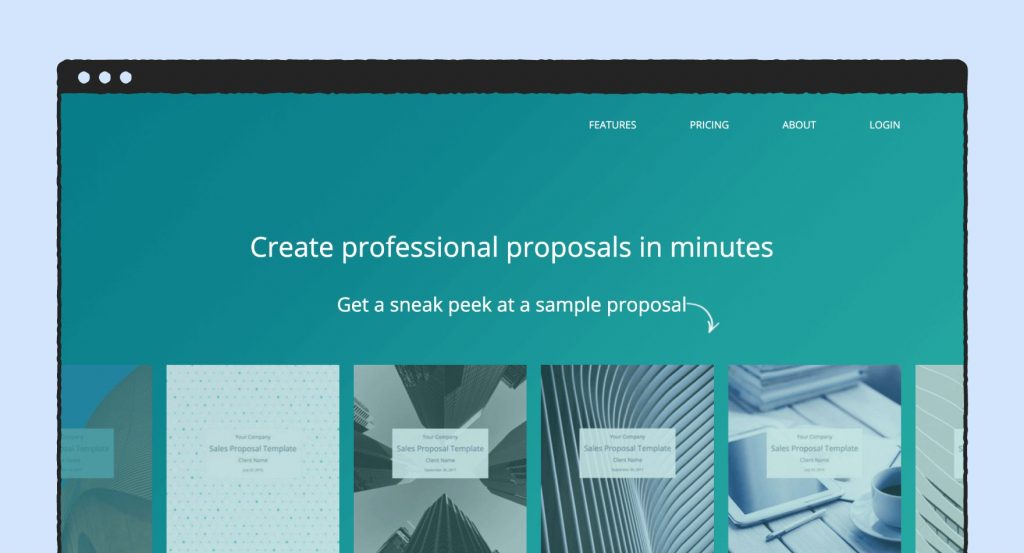
Our rating: 4.3/5
Pricing: Freelancer ($23/month); Studio ($47/month); Agency ($119/month). Start plan ($15/month) and free plans for non-profits also available.
Who is this tool for? Individuals and teams looking for a turnkey solution to proposal creation.
Bidsketch is a proposal software solution used by freelancers, consultants, salespeople, sales teams, agencies, and anyone closing deals.
The tool helps create professional-looking proposals in minutes using a customizable proposal builder and is designed with automation features to assist with the approval and onboarding process.
In addition to instant notifications and web-based proposal analytics, the tool offers beautiful proposal templates and custom client landing page creation.
With Bidsketch, you can reuse proposal templates, pricing items, content, and designs easily.
To help you get started quickly, the tool provides you with example content from the content library.
| Features | Proposify | Bidsketch |
|---|---|---|
| Legally-binding eSignatures with Audit Trail | 100 | X |
| Templates | ✓ | ✓ |
| Activities notifications | ✓ | ✓ |
| Payments collection | Stripe | ✓ |
| Automated workflows | X | X |
| Custom branding for documents, templates, and emails | ✓ | ✓ |
| CRM integrations | ✓ | Limited |
| eSignature API (including Sandbox API) | X | ✓ |
| Document generation and editing | ✓ | Limited |
| Document analytics and insights | ✓ | ✓ |
| Free trial | ✓ | ✓ |
| 24/7 customer service | Limited | Limited |
Proposify vs Bidsketch
As a proposal software, Bidsketch allows you to get up and running in minutes.
The interface is simple to use, and the proposal wizard makes it easy to understand where your content should go and how it should be arranged.
Compared to Proposify, the software is easier to grasp, and you’re unlikely to encounter any roadblocks or hiccups related to design and formatting.
(Proposify side steps these issues with templates, but content creation is more open-ended than what you’ll find in Bidsketch.)
That’s because Bidsketch doesn’t use a document interface like what you see in Proposify or PandaDoc.
It’s a document builder — meaning that you’ll need to input the required information in a series of text or dialog boxes.
At the end of the process, the software will build your document based on your design template and deliver it to you.
You can still perform some minor tweaks with the language once you receive the final output, but the design is already done.
By and large, builders offer a more “hands-off” approach to the design portion of the proposal creation process.
If you prefer to build documents using word processors, desktop publishing software, or drag-and-drop proposal tools like what Proposify offers, Bidsketch may feel a bit spare in the tools it offers.
This isn’t to say that Bidsketch is inferior. Similar to Qwilr (above), it’s simply a different approach to reach a similar outcome.
Bidsketch also comes equipped with several unique features, including its upselling feature.
Using this tool allows users to make line items optional so you can offer multiple sales packages to customers within the same proposal.
Aside from that, you’ll also have access to many standard sales features, including notifications, analytics, and collaboration tools.
While Bidsketch only offers a narrow selection of native integrations, it also provides API access and a Zapier integration so that users can connect to the rest of their tech stack.
That, combined with a wide selection of pricing options, makes Bidsketch a great option to consider if you’re looking to break away from Proposify.
And, if you’re looking for a deeper comparison between Bidsketch and Proposify, check out this article.
04. QuoteWerks
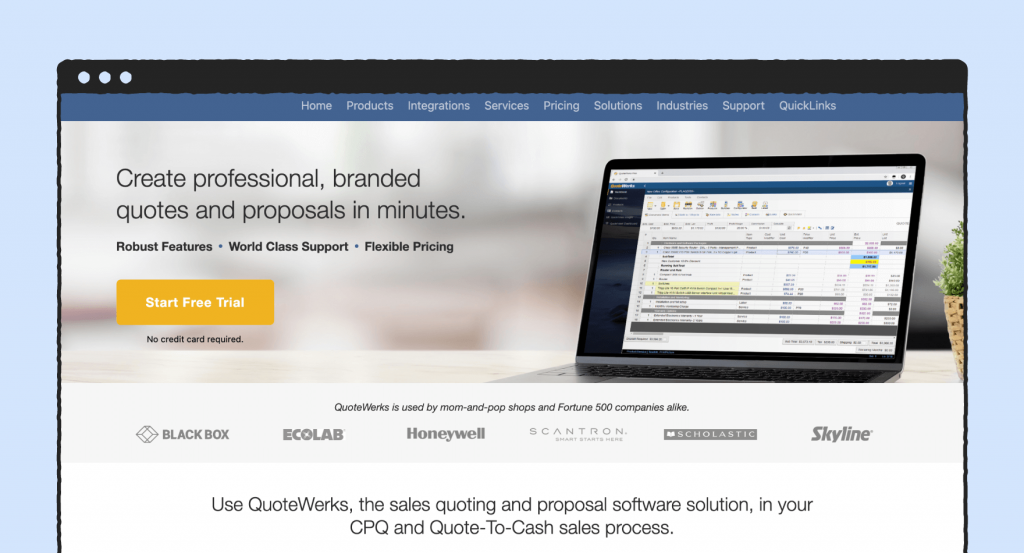
Our rating: 4.2/5
Pricing: Varies based on add-on selection. Prices range from $15/month for Standard Edition to $100+/month for Corporate Edition with add-ons included.
Who is this tool for? Teams who need to connect their proposal software to an end-to-end business process, from logistics and shipment to accounting and invoicing.
Depending on how you set it up and what you need it to do, QuoteWerks can act as a simple software solution or a robust selling platform with a deeply complex onboard database.
The software is scalable, and the features that you get are ultimately determined by the package that you choose.
This is, in many ways, the greatest advantage and drawback to QuoteWerks.
It has a learning curve and can take some time to set up properly, but the platform also offers a level of granularity and customization that you won’t see with any other platform.
For many, what QuoteWerks offers simply won’t be a good fit. But, especially for organizations working with a large number of product SKUs or a wide selection of services, QuoteWerks is definitely worth a look.
| Feature | Proposify | QuoteWerks |
|---|---|---|
| Legally-binding eSignatures with Audit Trail | ✓ | $ |
| Templates | ✓ | $ |
| Activity notifications | ✓ | ✓ |
| Payments collection | Stripe | Authorize.net or QuickBooks |
| Automated workflows | Limited | ✓ |
| Custom branding for documents, templates, and emails | ✓ | ✓ |
| CRM integrations | ✓ | Limited |
| API (including Sandbox API) | X | COM API |
| Document generation and editing | ✓ | ✓ |
| Document analytics and insights | ✓ | ✓ |
| Free trial | 14 Days | 30 Days |
| Customer Support | ||
| Email / Support Ticket | ✓ | ✓ |
| 24/7 Chat Support | X | X |
| Phone | $ | ✓ |
| Success manager | $ | X |
| Onboarding services | $ | $ |
Proposify vs QuoteWerks
The key difference between QuoteWerks and Proposify (in-depth review here) is how both these software tools align with the rest of your tech stack — and we’re not just talking about integrations.
Proposify styles itself as a proposal builder and handles that part of the sales process without major issues.
The platform places a much stronger emphasis on style and design than you’ll find in Quotewerks.
Using the drag-and-drop features in the Proposify toolkit, you’ll have granular control over the look and feel of your document in a way that you just won’t see with QuoteWerks.
That leaves an opening to make a powerful first impression.
On the other hand, QuoteWerks is designed as a quoting tool that can deal with a huge number of parts, SKUs, and services.
Even though the software interface looks like it would be right at home with the Windows XP user interface, it’s a tradeoff between form and function.
QuoteWerks is designed for operations that handle multiple parts and services. The platform acts as a quote builder, so your design over the final output is somewhat limited.
However, the flexibility that the software provides when building the quote is largely unmatched by Proposify.
It’s also worth noting that, while QuoteWerks has a web-based version and can integrate with cloud services and CRMs, it’s also the only option if you want to download software to your computer.
Proposify, like most quoting platforms, is browser-based. Only QuoteWerks offers a software download.
05. Better Proposals
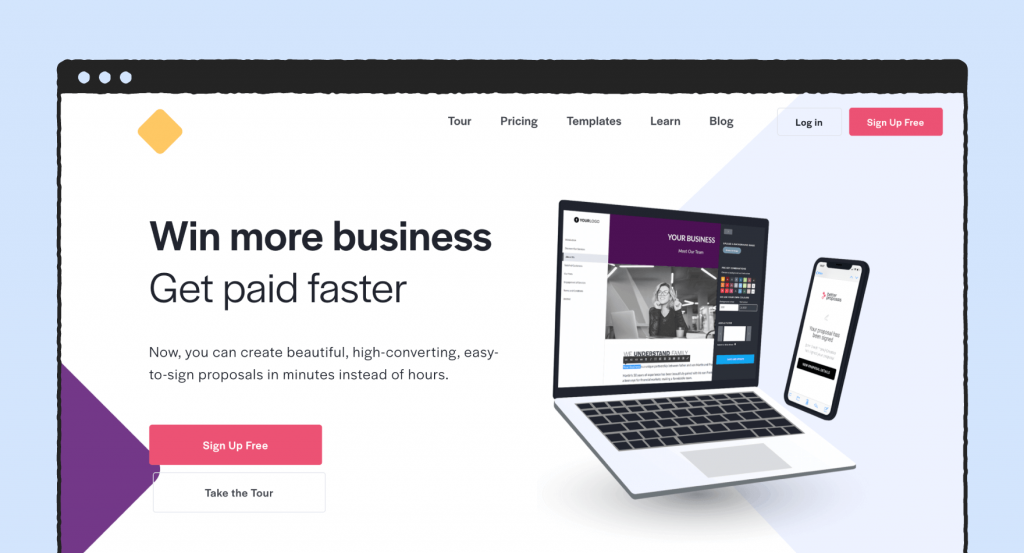
Our rating: 4.2/5
Pricing: Starter ($19/month); Premium ($29/month); Enterprise ($49/month).
Who is this tool for: Teams looking for a turnkey proposal solution that offers similar functionality to Proposify at a lower cost.
Better Proposals offers a proposal solution that is both simple to design and implement (great for teams) and easy to parse (great for leads and prospects).
The platform includes an all-in-one editor that is a mix of drag-and-drop tools combined with a pre-structured format that is unique to the Better Proposals platform.
This results in an editing tool that is easy to use, and it makes every proposal designed in the software have the same look and feel.
That can be a good thing or a bad thing, depending on your preferences.
However, the preset formats and tools like the built-in content library make proposal writing easier than ever and allow sales teams to focus on other aspects of their job.
For businesses who want something fast, friendly, and affordable, Better Proposals hits all the marks.
| Feature | Proposify | BetterProposals |
|---|---|---|
| Legally-binding eSignatures with Audit Trail | ✓ | ✓ |
| Templates | ✓ | ✓ |
| Activity notifications | ✓ | ✓ |
| Payments collection | Stripe | Stripe / Paypal |
| Automated workflows | Limited | ✓ |
| Custom branding for documents, templates, and emails | ✓ | ✓ |
| CRM integrations | ✓ | Limited |
| API (including Sandbox API) | X | ✓ |
| Document generation and editing | ✓ | Limited |
| Document analytics and insights | ✓ | ✓ |
| Free trial | 14 Days | 14 Days |
| Customer Support | ||
| Email / Support Ticket | ✓ | ✓ |
| 24/7 Chat Support | X | Limited |
| Phone | $ | X |
| Success manager | $ | X |
| Onboarding services | $ | Limited |
Proposify vs Better Proposals
It’s impossible to deny that Better Proposal users love the software.
The platform offers a structured approach to proposals, which allows for some creative freedom with guardrails to keep proposal creation process times acceptable.
This is different from Proposify, which offers a more open-ended approach to proposal creation — but it’s not a bad thing.
Like Proposify, Better Proposals builds proposals in a block-based format.
You’ll add content blocks to your proposal as you work your way through a section, building as you go. You can add text, images, and colored backgrounds with relative ease.
The key difference between these two design platforms is how the content you design is structured.
Proposify builds its content based on a traditional page layout, meaning that the end result looks and feels like a standard proposal.
It can be printed, and the output on paper will (roughly) match what you see on the screen.
While you still have a large amount of flexibility and can choose to ignore print layouts entirely when using Proposify, it’s impossible to deny that the platform was built using the standard page layout as its original canvas.
By contrast, Better Proposals doesn’t do any of that. Instead, the platform relies on an always-visible, left-hand sidebar for navigation.
Users will click through the various subheadings, which load different sections of the proposal in the viewing window on the right-hand side.
The key difference: Better Proposals pages don’t follow any standardized page layout.
Blocks can be stacked atop one another with no consideration given to print layouts or standard page formats.
In some ways, this is great because it allows users to break away from outmoded design concepts.
On the other hand, it’s possible that you’ll still have customers who just want to print things out on paper.
In fairness to Better Proposals, the tool does offer the ability to print or download proposals as a PDF — but it’s clear that the proposals were largely meant to be viewed online.
Everything from the sidebar structure to the open-endedness of the pages points to those preferences, so it’s something to consider if you’re thinking about switching platforms.
The software tools are similar in other areas. Both apps come with a healthy number of integrations and bring tools like tracking, analytics, and notifications to the table.
You’ll also be able to e-sign and collect payments using this tool, so it’s definitely one to check out if you’re looking for an affordable, all-in-one proposal solution.
06. Proposable
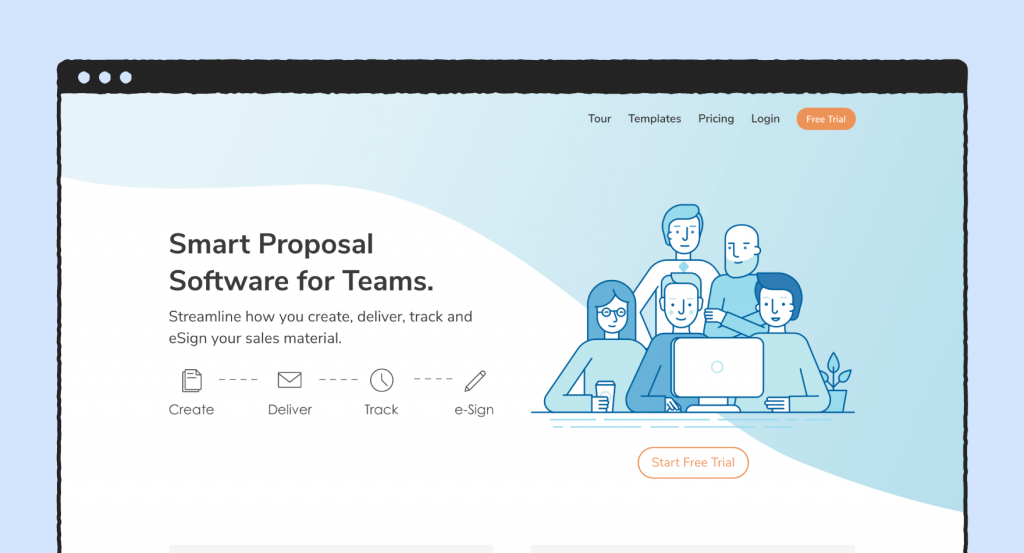
Our rating: 4.3/5
Pricing: Solo ($19/month); Team ($39/month); Enterprise ($500+/month).
Who is this tool for: Users looking for end-to-end proposal building and delivery solutions as an affordable price.
Proposable is a tool designed to help salespeople supercharge their sales proposals and gain fresh insight into the complete sales process.
The tool automates the entire proposal process, from creating and sending trackable web-based proposals to collaborating with stakeholders, and closing the deal with incorporated e-signatures tools.
In many ways, Proposable brings a little bit of everything to the table, and it does so at a relatively affordable price point.
| Feature | Proposify | Proposable |
|---|---|---|
| Legally-binding eSignatures with Audit Trail | ✓ | ✓ |
| Templates | ✓ | ✓ |
| Activity notifications | ✓ | ✓ |
| Payments collection | Stripe | Stripe |
| Automated workflows | Limited | ✓ |
| Custom branding for documents, templates, and emails | ✓ | ✓ |
| CRM integrations | ✓ | Limited |
| API (including Sandbox API) | X | X |
| Document generation and editing | ✓ | ✓ |
| Document analytics and insights | ✓ | ✓ |
| Free trial | 14 Days | 14 Days |
| Customer Support | ||
| Email / Support Ticket | ✓ | ✓ |
| 24/7 Chat Support | X | Limited |
| Phone | $ | X |
| Success manager | $ | X |
| Onboarding services | $ | X |
Proposify vs Proposable
In many ways, both Proposable and Proposify bring similar product offerings to the table.
Both tools allow for from-scratch document creation that includes a web editor, custom branding solutions, and pre-build templates.
Users will also have access to many of the same tools when it comes to the proposal building process.
So, what are the main differences?
Most of the daylight that you’ll see between these two platforms comes to the execution of the main feature set.
And, hands down, Proposify does it better. From layout and design all the way to the user dashboard, Proposify offers a user experience that feels more premium and well-planned than what you see in Proposable.
The Proposify editor is more robust and offers a greater level of functionality.
It also feels nicer to use, which may be a factor when designing and personalizing your sales quotes and proposals.
On the other hand, if you’re more focused on implementation than design, Proposable may be everything you need.
The UI offers most of the same functionality that you’ll see in Proposify, but without the frills and emphasis on design and backend user experience.
The proposals still look great for customers, and the basic usage principles are the same for sales teams and proposal designers.
Like Proposify, Proposable designs around a standard page size, so documents can be viewed online or printed/saved as PDFs while retaining their same look and feel.
Aside from the overall execution of the product, these solutions are quite similar. That certainly makes Proposable worth a look if you’re looking for a Proposify alternative.
07. Nusii
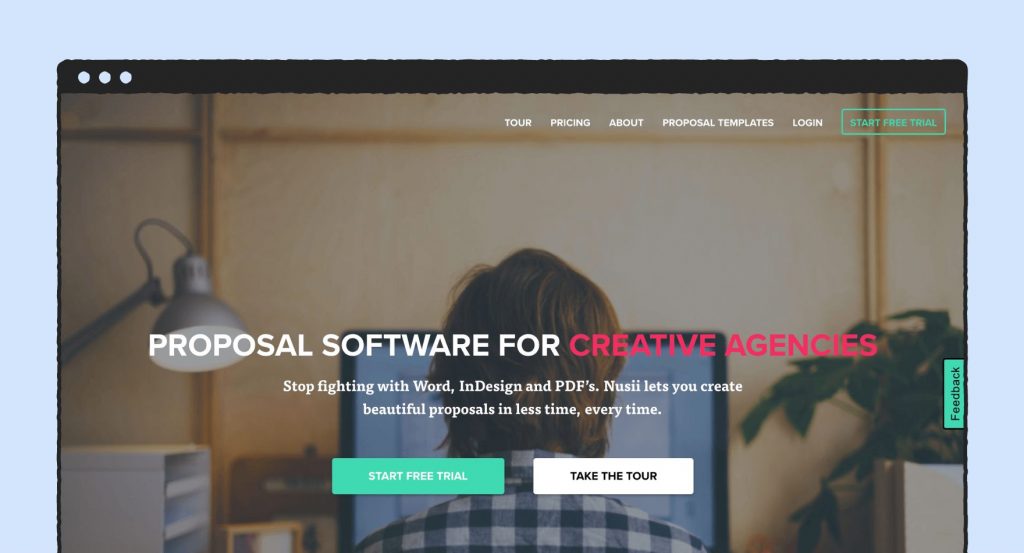
Our rating: 4.7/5
Pricing: Freelance ($29/month); Studio ($49/month), Agency ($129/month).
Who is this for: Teams looking for streamlined proposals that are both easy to build and easy to read.
Nusii positions itself as a web-based proposal builder designed to replace Word, InDesign, and PDF with a simple-to-use browser interface.
The platform offers branding options, a from-scratch document editor, automation through templates and recyclable content, and a host of integrations with CRMs, payment gateways, and productivity tools.
The goal of all this? To streamline your proposal workflow so that you can get proposals out the door as quickly as possible.
The block-based builder and formatting tool makes it easy to style your proposals with text, images, and video.
You’ll also have access to interactive pricing tools so that you can offer flexible solutions to customers.
All of that, combined with an e-signing solution and instant notifications, gives you everything you need to build proposals at lightning speed.
| Nusii | Proposify | Nusii |
|---|---|---|
| Legally-binding eSignatures with Audit Trail | ✓ | ✓ |
| Templates | ✓ | ✓ |
| Activity notifications | ✓ | ✓ |
| Payments collection | Stripe | Stripe |
| Automated workflows | Limited | ✓ |
| Custom branding for documents, templates, and emails | ✓ | ✓ |
| CRM integrations | ✓ | ✓ |
| API (including Sandbox API) | X | ✓ |
| Document generation and editing | ✓ | ✓ |
| Document analytics and insights | ✓ | ✓ |
| Free trial | 14 Days | 14 Days |
| Customer Support | ||
| Email / Support Ticket | ✓ | ✓ |
| 24/7 Chat Support | X | Limited |
| Phone | $ | X |
| Success manager | $ | X |
| Onboarding services | $ | X |
Proposify vs Nusii
Both Nusii and Proposify are designed to fill a similar niche in your sales process.
You won’t need both, and which platform is the better fit will come down to your preferences around design, customization, and branding.
Unfortunately for Nusii, Proposify has a pretty clear edge here.
Nusii proposals largely consist of an image or video at the top, a collection of text interspersed with various media, a pricing table, and a workflow for readers to either accept or reject the proposal.
While you can use the built-in editor to add some layers of complexity, you’ll be limited in scope by the design capabilities of the software at hand.
The result? Every Nusii proposal looks roughly the same.
You can change a few things here and there, but like so many Proposify competitors that we look at, none really compare to the breadth of design and layout options that Proposify offers to its customers.
However, design isn’t the have-all/end-all of sales documentation.
Nusii proposals are serviceable. They get the job done, look nice, and don’t take hours of painstaking labor to create.
For teams who want to make a good first impression but aren’t interested in falling into the weeds when it comes into layouts, Nusii is a great choice.
Outside of design and layout, Nusii offers the standard fare of features and solutions that you see in most proposal builders we’ve covered.
You can add custom branding solutions (including a custom domain), integrate with CRMs, integrate with various productivity and CRM tools, and much more.
One important thing to note is that Nusii’s Agency plan runs $49/month and includes five users, meaning that you can secure a proposal software solution for a small sales team at roughly one-fifth of what it would cost to climb into a Proposify subscription.
Especially for small teams who need something fast, simple, and affordable, Nusii does a great job striking a balance on all points.
Of course, there may be other competitors to consider, as well.
08. GetAccept
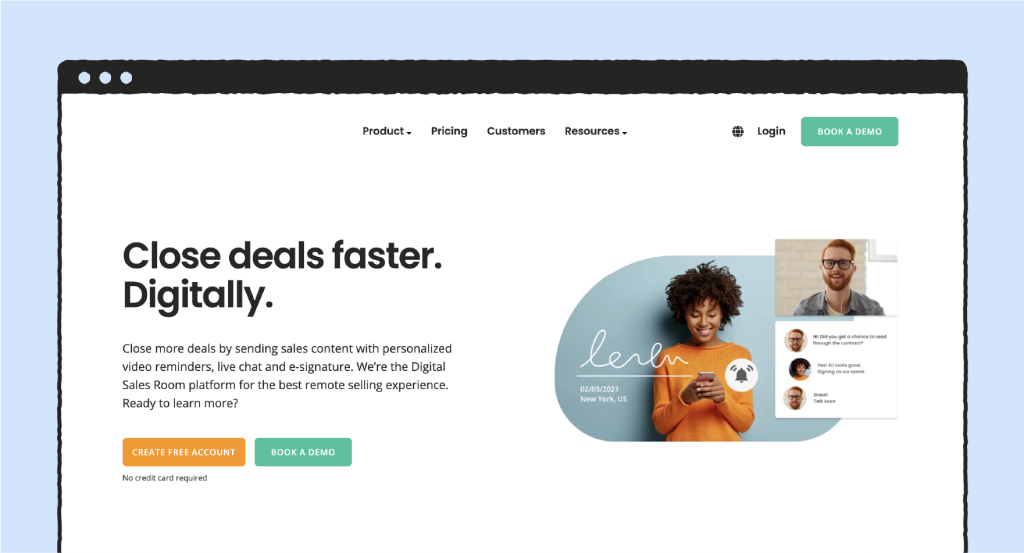
Our rating: 4.7/5
Pricing: Essential ($15/month); Professional ($39-$79/month); Enterprise plan available.
Who is this for?: Teams looking for software tools to manage their end-to-end sales process.
GetAccept is a great all-in-one proposal software for sales teams of all sizes.
It’s equipped with the tools you’ll need to create proposals from scratch, manage them through their full lifecycle, and stay closely connected with your customers along the way.
Key features include e-signing, digital sales rooms, pricing tables, content libraries, analytics, CRM integrations, and much more.
| Feature | Proposify | GetAccept |
|---|---|---|
| Legally-binding eSignatures with Audit Trail | ✓ | ✓ |
| Templates | ✓ | ✓ |
| Activity notifications | ✓ | ✓ |
| Payments collection | Stripe | Stripe, Chargebee, Authorize.net |
| Automated workflows | Limited | ✓ |
| Custom branding for documents, templates, and emails | ✓ | ✓ |
| CRM integrations | ✓ | Limited |
| API (including Sandbox API) | X | $ |
| Document generation and editing | ✓ | ✓ |
| Document analytics and insights | ✓ | ✓ |
| Free trial | 14 Days | ✓ |
| Customer Support | ||
| Email / Support Ticket | ✓ | ✓ |
| 24/7 Chat Support | X | ✓ |
| Phone | $ | X |
| Success manager | $ | $ |
| Onboarding services | $ | X |
Proposify vs GetAccept
If you’re comparing Proposify and GetAccept, you’ll quickly notice that the products share some overlap in their intended use case and purpose.
That’s because GetAccept is one of the few proposal platforms (along with Proposify and PandaDoc) that allows you to create documents from scratch inside an online editor.
The GetAccept editor comes with a battery of tools to help you stay connected to your customer.
You can add images and text blocks, create customized proposals using saved templates, and even personalize content with built-in video tools.
After you send your content to customers for review, you’ll even be able to monitor access using document analytics and live chat with clients to answer questions in real-time to keep the deal moving forward.
GetAccept also offers a selection of tools to carry your deal even further after proposals and contracts are dispatched.
Every opportunity is attached to a deal room, which serves as a repository for your sales documents, supporting information, and stakeholder communications.
This sets the platform apart from Proposify, which is primarily focused on the design and creation of sales documentation.
While, comparatively, the Proposify editor brings more to the table in the document design process, GetAccept offers a wider range of tools to manage more of the sales process.
There are a few downsides to consider, especially on lower-tiered plans, where you’ll see reduced functionality around integrations, branding, and analytics.
However, thanks to the wide selection of pricing options, you can likely find a plan with a feature set that suits your unique needs.
In some ways, GetAccept goes overboard here. Counting enterprising pricing options, you have seven bundle options to choose from.
That’s notable, particularly in an industry where most companies offer two or three options prior to enterprise-level pricing.
At the same time, this is approach provides more flexibility than what you’ll see with Proposify, which only offers a single $50/month plan before jumping into enterprise pricing (also available on GetAccept).
09. DealHub
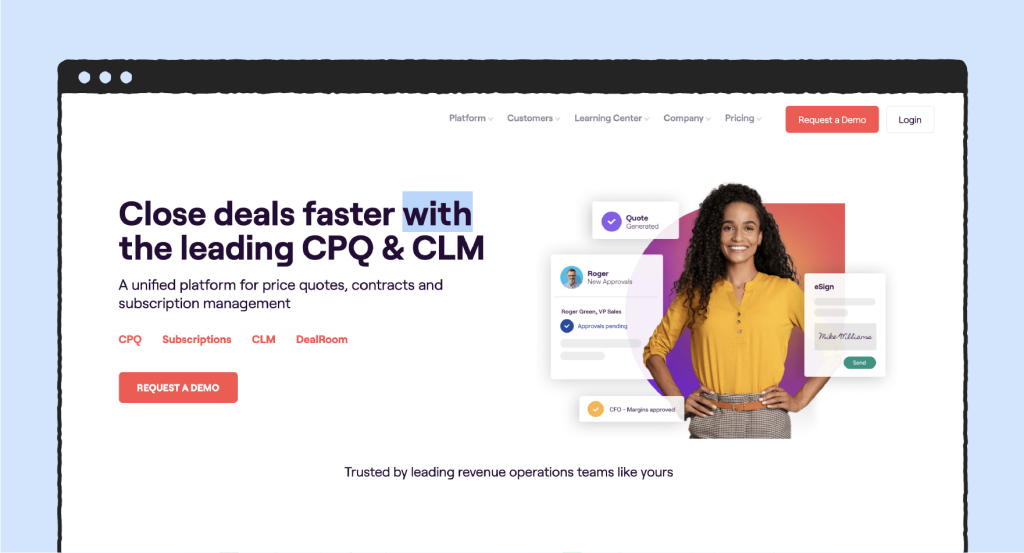
Our rating: 4.5/5
Pricing: Quotes only available by contacting sales.
Who is this for: Organizations seeking tools to boost their selling process.
DealHub is a great CPQ software for teams who want to create an immersive experience for customers during every stage of the sales process.
The platform is equipped with tools to streamline sales workflows and to help all teams and stakeholders operate from a single source of truth during the sales process.
| Feature | Proposify | DealHub |
|---|---|---|
| Legally-binding eSignatures with Audit Trail | ✓ | ✓ |
| Templates | ✓ | ✓ |
| Activity notifications | ✓ | ✓ |
| Payments collection | Stripe | X |
| Automated workflows | Limited | ✓ |
| Custom branding for documents, templates, and emails | ✓ | ✓ |
| CRM integrations | ✓ | Limited |
| API (including Sandbox API) | X | Limited |
| Document generation and editing | ✓ | Limited |
| Document analytics and insights | ✓ | ✓ |
| Free trial | 14 Days | Demo Only |
| Customer Support | ||
| Email / Support Ticket | ✓ | ✓ |
| 24/7 Chat Support | X | X |
| Phone | $ | ✓ |
| Success manager | $ | ✓ |
| Onboarding services | $ | ✓ |
Proposify vs Dealhub
Dealhub bills itself as more of a collaborative platform than a document creation tool. And, at some level, that’s probably true.
Where Proposify is interested in helping you create content to help you close deals, Dealhub tries to act as a single source of truth to put all deal-related information in a single place.
This includes discovery sessions, proposal content, quoting, buying, and post-deal negotiations.
There is a surprising amount of overlap between these two products because, like Proposify, DealHub offers sales proposals and e-signing tools.
Speaking purely in terms of document creation, Proposify outshines DealHub’s capabilities.
DealHub offers document generation, allowing users to set up templates and input information to receive formatted proposals.
However, document generation lacks the granular control that you’ll see in an open-ended editor like Proposify.
On the other hand, DealHub includes tools for guided selling, subscription-based selling, and much more.
If you’re looking for a Proposify alternative that could potentially replace large chunks of your sales process, DealHub might be worth exploring, but you may also be taking a step back when it comes to true document generation by offloading that work to a traditional word processor.
If that doesn’t sound interesting to you, DealHub probably isn’t the way forward despite its arsenal of features.
10. Prospero

Our rating: 4/5
Pricing: $10/month per user up to 24 users. At 25 users, Enterprise pricing is available.
Who is this for: Companies of all sizes who want to create straightforward proposals.
Prospero is a proposal design software that is clearly angled toward freelancers and smaller organizations.
Despite this, the tool is loaded for bear with proposal design tools that make it a formidable option for much larger companies.
For a relatively low cost, you’ll gain access to all of Prospero’s features, including a content library, digital signing tools, document analytics, and more.
| Feature | Proposify | Prospero |
|---|---|---|
| Legally-binding eSignatures with Audit Trail | ✓ | ✓ |
| Templates | ✓ | ✓ |
| Activity notifications | ✓ | ✓ |
| Payments collection | Stripe | Stripe |
| Automated workflows | Limited | X |
| Custom branding for documents, templates, and emails | ✓ | Limited |
| CRM integrations | ✓ | X |
| API (including Sandbox API) | X | X |
| Document generation and editing | ✓ | Limited |
| Document analytics and insights | ✓ | ✓ |
| Free trial | 14 Days | 14 Days |
| Customer Support | ||
| Email / Support Ticket | ✓ | ✓ |
| 24/7 Chat Support | X | X |
| Phone | $ | X |
| Success manager | $ | X |
| Onboarding services | $ | X |
Proposify vs Prospero
At first glance, Prospero might look like a tool that only hits the marks for smaller organizations.
There is some truth to that, particularly if you want to integrate your entire tech stack into your proposal software in order to automate your data inflow.
If you’re looking to scale your operation in that way, Prospero might not be for you.
The platform offers some integration options, primarily for accounting/finance and small team productivity.
As a proposal design tool, Prospero brings a lot to the table.
The in-app document designer feels comfortable and easy to use.
While it lacks the granular control that you’ll see in Proposify, you can make relatively complex documents using the drag-and-drop interface.
It’s worth noting that even small businesses may need to build their own proposal templates rather than relying on the Prospero template library.
The proposal formats within the template library are clearly geared toward freelancers and solo operators, where Prospero finds its roots.
As with other editors that we’ve seen, Prospero offers a preset format to its proposals.
Every content block features a header and subhead on the left-hand side of the page, while the body content sits on the right-hand side.
This format can’t be changed, so your proposals all follow a similar format and layout.
If you can look past that, the platform is worth considering, especially if you don’t need the design power that Proposify offers.
That’s particularly true when you consider that Prospero costs one-fifth the price on a monthly retainer compared to Proposify.
If you take an annual subscription, you can drive the cost even lower, down to roughly $8/month per seat!
Other Proposify alternatives
While the 10 options we’ve listed above are prime competitors to Proposify, there are plenty of other options out there.
These software tools aren’t necessarily direct competitors to Proposify because they lack some of the key features that Proposify offers, but they might be a great fit for specific organizations with unique needs.
- Qvidian. An RFP response software, Qvidian allows storing all approved proposal content and best RFP responses in a single, easily accessible library, available to all team members. The goal of the software is to cut down the time it takes to build RFPs by creating a centralized content library and recycling answers to common questions.
- RFP360. Another RFP response software, RFP360 is designed around outsourcing RFI requests to subject matter experts within your organization and consolidating their responses to produce an RFP response document. The platform leverages a healthy amount of process workflows and reporting tools to help users project manage the RFP process.
- ClientPoint. This platform acts as a repository for all documents, including brochures, videos, and more. Using the onboard document generator and a few templates, teams can stitch together sales documentation based on the assets within the content library. This can be used to create proposals, contracts, or marketing materials. Compared to Proposify, it’s enormously expensive, with the base plan starting at well over $1500/month.
- Bonsai. A business operations platform targeting freelancers, Bonsai offers some proposal creation alongside other business management tools like CRMs and billing systems. The platform is designed specifically for smaller organizations and is unlikely to scale with the needs of larger organizations.
Where we got our data
The data used in this article was sourced and analyzed from more than 20 different websites.
The websites used for the analysis include specialized SaaS websites, user-review websites, as well as other relevant publications in the SaaS industry.
To make sure the most relevant websites were prioritized in the analysis, all websites were split into four cohorts, based on the number of visits they generate.
Here, the number of visits was used to assess the relevance of respective publications.
These were the four cohorts:
- >250.000 visits;
- 150.000 – 250.000 visits;
- 25.000 – 150.000 visits;
- < 25.000 visits
Each website was then assigned a score based on their group.
Therefore, the websites that occupy the last group were considered less objective or trustworthy and required more vetting due to the low number of visits they generate.
On the other hand, the websites from the first two groups were considered more reliable and were prioritized during the analysis.
Here are some examples of websites that were considered relevant:
- Best proposal management software from Capterra
- Proposal software overview on TrustRadius
- Proposify reviews on GetApp
Finally, the websites of the covered tools were also included as content sources.
However, they were stripped of their biases and marketing claims and only used to confirm data related to the actual tool, its features, pricing plans, and others.
Final thoughts
Without a doubt, Proposify offers one of the best cloud-based solutions to design an online proposal. Other providers offer beautiful templates and better selling tools, but we’d have to give the design award (in most circumstances) to Proposify.
That’s not to say that the other Proposify alternatives are a bad choice, but it all comes down to what you’re looking for in your proposal tool and how much ground you want that tool to cover.
After all, Proposify has its gaps, too. Other platforms do a better job with outreach and follow-up or may boost your business process in some other way.
Any of the tools from our list can be your best alternative to Proposify as each of these SaaS solutions has something unique to them.
So, get ready, choose a platform you like most, and start exploring the beauty of proposal software! Many of these software solutions offer a free trial, so you can give them a test drive at no risk.
Looking for a good place to start? Sign up for a free 14-day trial with PandaDoc and go from there.
Disclaimer
PandDoc is not a law firm, or a substitute for an attorney or law firm. This page is not intended to and does not provide legal advice. Should you have legal questions on the validity of e-signatures or digital signatures and the enforceability thereof, please consult with an attorney or law firm. Use of PandaDocs services are governed by our Terms of Use and Privacy Policy.
Originally published May 6, 2019, updated June 19, 2023
